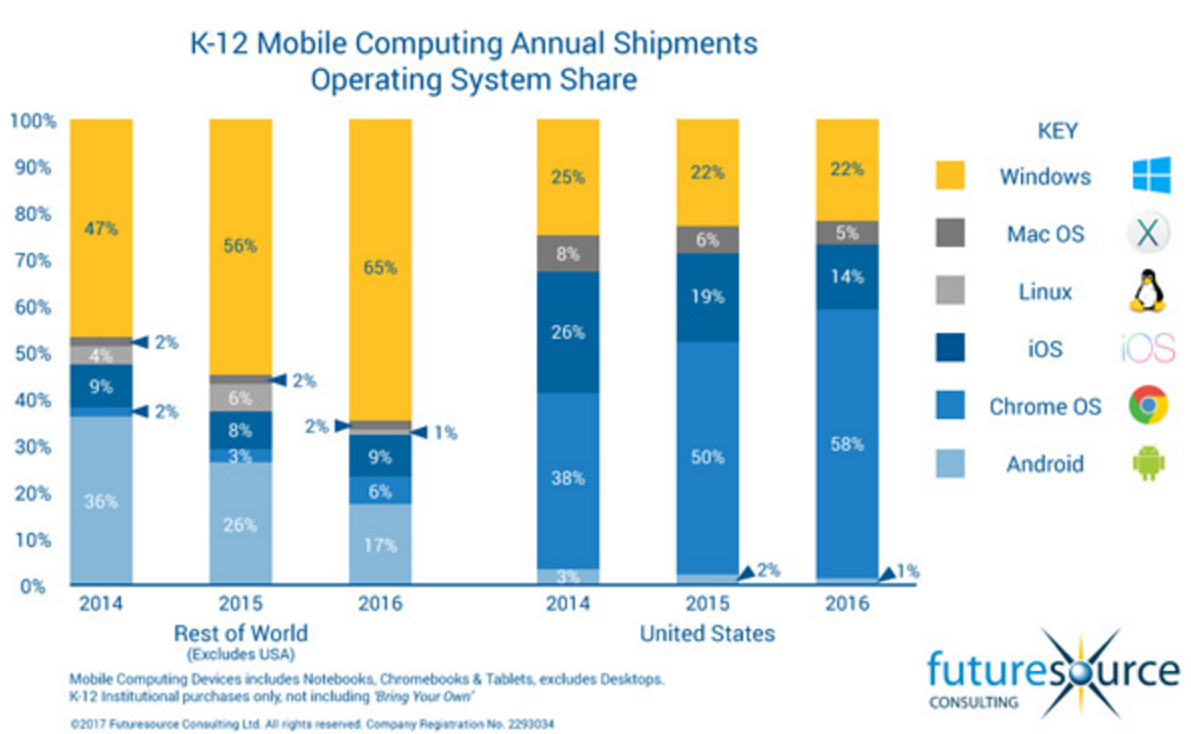Windows Cloud + Education: The Challenge Microsoft Must Solve
Next week, Microsoft is hosting an event in NYC where the company is expected to announce Windows Cloud. The invite points to the fact that this is an education focused event and if the company wants to push back against Chromebooks and iPads, they have a tough challenge ahead.
Stepping back and looking in, the education market is vastly different from the corporate and personal computing segments. For starters, cost, durability, serviceability, and warranty are highly important. Sure, you could argue this is the same for everyone else but in education a four-year warranty is ideal, rugged devices are essential, and they need a simple interface as well.
Everything I wrote above is not new and represents the reasons Chromebooks have done so well. They are inexpensive, they have a good browser, easy to manage and are almost disposable at prices starting around $199.
FutureSource recently shared their data on operating system share based on the annual shipment for the education market and it shows that Chrome OS is taking a large slice of the market share pie, 58% in the US, up from 50% last year, and you can begin to understand why Microsoft is concerned. It is worth pointing out that the company holds a significantly larger portion of the market share outside the US but on the company’s home turf, they have room for growth.
In education, time is not a luxury. A teach has a full plate of educating the students, lesson planning, grading papers, keeping the class organized and focused on the task, dealing with deadlines to keep students on track to pass standardized testing, dealing with parents and a lot more. What teachers do not have time to do is triage why a computer is not working; they must work, every time, all the time.
Windows Cloud will be a version of Windows that is locked to only running Windows Store applications. In theory, this should make the computer more reliable and less likely to have the software ‘broken’ by a student but when things don’t work, this is the problem Microsoft must solve.
With Chromebooks, they can be reset almost instantly, Windows Cloud must do the same. Having the machine tied to an Active Directory account and provisioned by an IT Pro is great but in the classroom, you don’t have the luxury of waiting for IT to fix the problem. In an ideal world, Windows Cloud would offer a stateless machine, one that could be instantly reset to the pre-configured image by IT and have this all be done by the teacher.
Microsoft has, or had this technology with Steady State, which offered the ability to revert a computer to a previously stored state every time it reboots, or on administrator’s request. This software is no longer supported and was supported up until December of 2010.
For Microsoft to succeed in education, they need to empower the teacher to become an IT Pro. This does not mean hours of training as they do not have the luxury to become tier one tech support but offering a way, be it either a keyboard shortcut, an option in the settings menu, or somewhere else, that instantly resets the device back to a known good state.
Downtime in the classroom is not an option, teachers can’t fix software problems nor should they have to. This is the reason Chromebooks have become popular; low maintenance, easy to reset, and reliable. For Microsoft, they need to not only match Chromebook’s capabilities but best it in software without introducing complexity.
If Microsoft can make Windows Cloud easy enough to manage that a teacher can fix 99% of the problems students encounter, then they stand a chance at taking back the market that ChromeOS has captured.
It’s a bit too early to say if Windows Cloud is going to be a success in this segment as we don’t know all that pieces of the story. But, next week, when I am sitting in NYC watching Microsoft announce this OS and possibly some new hardware, I’ll be watching closely to see how they solve the “something is wrong and I need to fix it right now” challenge.





